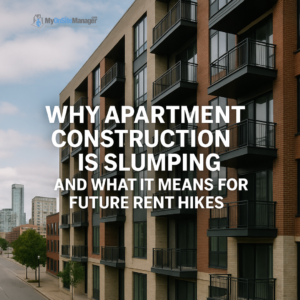As renters across the U.S. continue to search for affordability, there’s an invisible force tightening the market: a steep slowdown in new apartment construction. While rent growth cooled temporarily in many metro areas over the past year, that relief may be short-lived. A sharp drop in housing development activity is now signaling a future where rents could surge again—possibly faster than before.
Let’s explore the key reasons behind this construction pullback, how it’s playing out in major cities, and what it means for renters in the months ahead.
The Construction Decline: Fewer Permits, Fewer Units
According to Redfin and U.S. Census data, multifamily construction permits are plummeting. Between April 2024 and March 2025, only 12.4 apartment permits were filed per 10,000 residents, a sharp decline from pandemic-era and even pre-pandemic averages.
In roughly 63% of the top 100 U.S. metro areas, the number of new permits issued has declined compared to the peak of apartment building seen in 2022 and 2023. For renters, this means that even though some units are still being completed, the pipeline of future apartments is drying up.
What’s Causing Developers to Hit Pause?
Several economic headwinds are responsible for the slowdown:
-
High Interest Rates: Elevated borrowing costs make financing new construction significantly more expensive for developers. Many projects that were once feasible are now shelved or delayed indefinitely.
-
Rising Construction Costs: From labor to materials, the cost of building an apartment has soared. For example, in the Twin Cities, it now costs over $320,000 per unit to build, yet many properties only sell for around $223,000—a financial mismatch that halts new development unless public subsidies or incentives are involved.
-
Tariffs and Material Shortages: Ongoing tariffs on building materials—particularly imports—have inflated prices further, adding pressure to already stretched project budgets.
According to Redfin Senior Economist Sheharyar Bokhari, developers are being cautious: “They’re pumping the brakes. High interest rates and construction costs are making new development too risky or too expensive to justify.”
How This Trend Is Playing Out in Key Cities
Here’s a closer look at how the slowdown is affecting individual markets:
Twin Cities (Minneapolis–St. Paul)
-
Permits fell from 15,500 in 2022 to just 5,000 in 2024.
-
Only 733 permits were filed in the first three months of 2025.
-
With construction costs significantly outpacing expected returns, many developers are walking away unless affordable housing subsidies are available.
Seattle
-
The city approved only 21.2 permits per 10,000 residents, a steep drop from recent years.
-
Around 14,700 units were under construction as of spring 2025—nearly half of what was underway in 2023.
-
A future shortage is expected, especially as completed projects are absorbed by the market faster than they’re being replaced.
San Antonio
-
Issuing 15 permits per 10,000 residents, compared to 34.1 during the pandemic building surge.
-
Still higher than some metros, but the decline could impact affordability in the long term as population growth continues.
The Coming Rent Rebound: What Renters Can Expect
While some renters enjoyed a brief pause in price hikes, this new wave of underbuilding is setting the stage for another round of rent increases. Here’s why:
-
Supply Is Drying Up: The number of new units being planned and approved is shrinking. As the current stock fills up, options for renters will become more limited.
-
Demand Remains Strong: Millennials and Gen Z renters are still entering the market in large numbers. Many would-be homebuyers are also staying renters longer due to high mortgage rates, further increasing rental demand.
-
Increased Competition: In high-growth cities, even a small mismatch in supply and demand can lead to significant rent jumps—especially when vacancy rates fall.
What’s Next?
Without a turnaround in construction activity—or bold government intervention—rents could surge again by late 2025 into 2026, especially in fast-growing metro areas.
Policy solutions like zoning reform, expedited permitting, or increased funding for affordable housing development may be needed to correct the imbalance. Until then, renters should brace for tighter markets and fewer affordable options in many cities.
Final Thoughts
This construction slowdown might not be obvious at street level—but it’s happening behind the scenes and will shape the housing landscape in the next 12–24 months. If you’ve been enjoying more stable rent prices recently, consider it a temporary window of relief.
The message is clear: without more units being built, the pressure on the rental market is bound to return—and possibly with more force than before.

